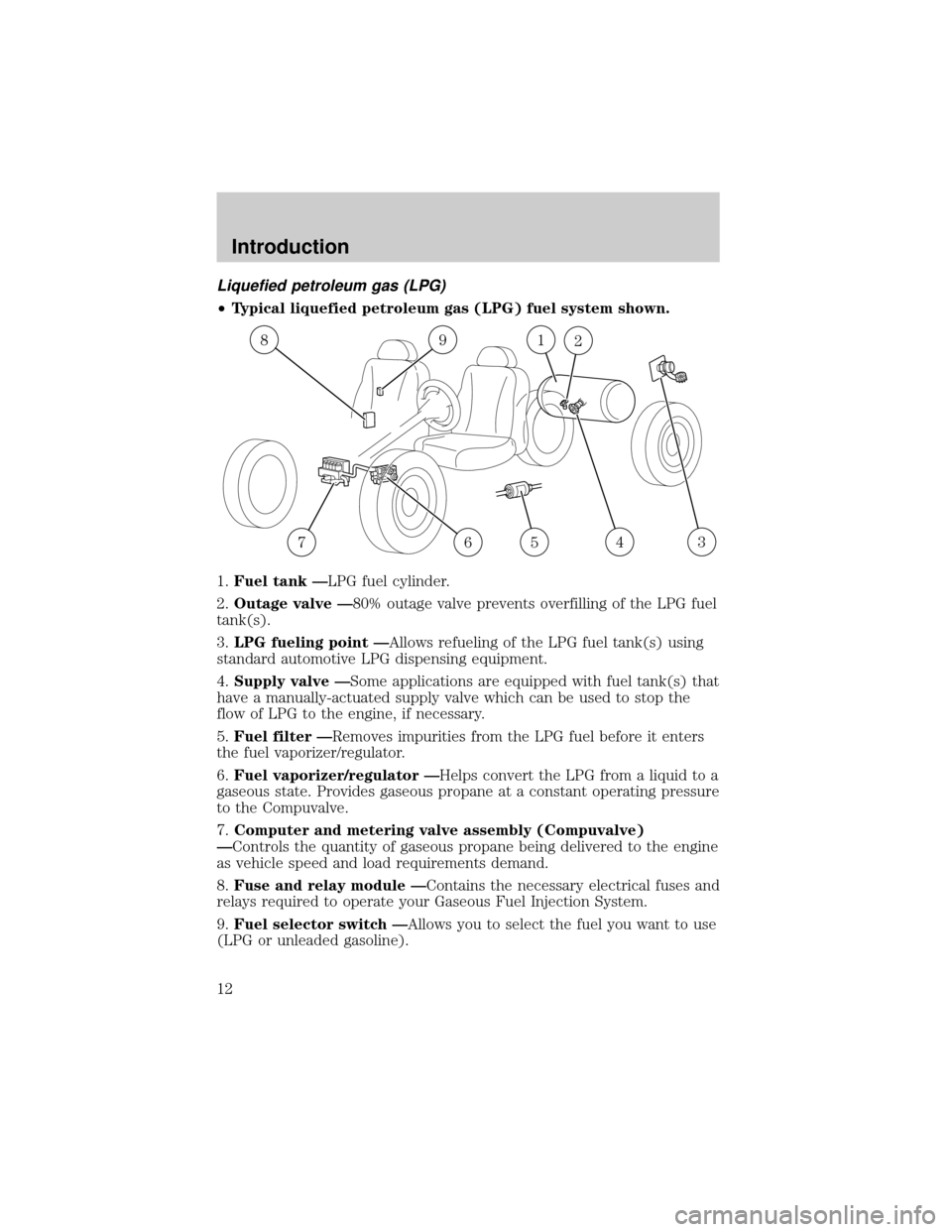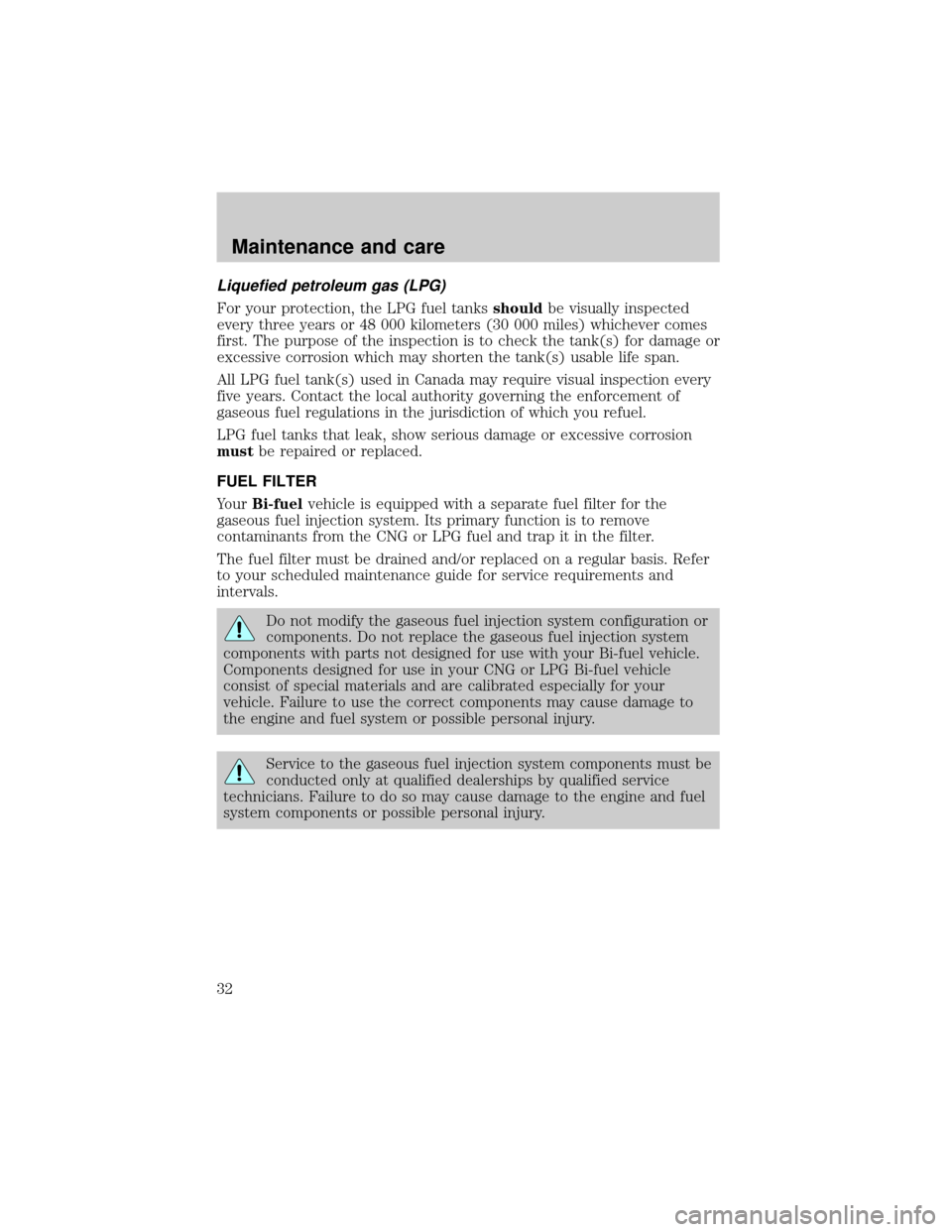Page 11 of 32

Compressed natural gas (CNG)
²Typical compressed natural gas (CNG) fuel system shown.
1.Fuel tank ÐCNG fuel cylinder. Depending upon application, more
than one fuel tank may be used.
2.Solenoid tank valve ÐOne electronically-actuated (normally closed)
solenoid valve that will automatically stop the flow of CNG from the fuel
tank(s) when the engine is turned off.
3.CNG fueling point ÐAllows refueling of the CNG fuel tank(s) using
standard automotive natural gas dispensing equipment.
4.Coalescent fuel filter ÐRemoves impurities from the natural gas
before it enters the high pressure fuel regulator.
5.High pressure fuel regulator ÐReduces fuel pressure from the fuel
tank(s) to 690 kPa (100 psi).
6.Computer and metering valve assembly (Compuvalve)
ÐControls the quantity of natural gas being delivered to the engine as
vehicle speed and load requirements demand.
7.Fuse and relay module ÐContains the necessary electrical fuses and
relays required to operate your Gaseous Fuel Injection System.
8.Fuel selector switch ÐAllows you to select the fuel you want to use
(CNG or unleaded gasoline).
Introduction
11
Page 12 of 32

Liquefied petroleum gas (LPG)
²Typical liquefied petroleum gas (LPG) fuel system shown.
1.Fuel tank ÐLPG fuel cylinder.
2.Outage valve Ð80% outage valve prevents overfilling of the LPG fuel
tank(s).
3.LPG fueling point ÐAllows refueling of the LPG fuel tank(s) using
standard automotive LPG dispensing equipment.
4.Supply valve ÐSome applications are equipped with fuel tank(s) that
have a manually-actuated supply valve which can be used to stop the
flow of LPG to the engine, if necessary.
5.Fuel filter ÐRemoves impurities from the LPG fuel before it enters
the fuel vaporizer/regulator.
6.Fuel vaporizer/regulator ÐHelps convert the LPG from a liquid to a
gaseous state. Provides gaseous propane at a constant operating pressure
to the Compuvalve.
7.Computer and metering valve assembly (Compuvalve)
ÐControls the quantity of gaseous propane being delivered to the engine
as vehicle speed and load requirements demand.
8.Fuse and relay module ÐContains the necessary electrical fuses and
relays required to operate your Gaseous Fuel Injection System.
9.Fuel selector switch ÐAllows you to select the fuel you want to use
(LPG or unleaded gasoline).
192
35467
8
Introduction
12
Page 32 of 32

Liquefied petroleum gas (LPG)
For your protection, the LPG fuel tanksshouldbe visually inspected
every three years or 48 000 kilometers (30 000 miles) whichever comes
first. The purpose of the inspection is to check the tank(s) for damage or
excessive corrosion which may shorten the tank(s) usable life span.
All LPG fuel tank(s) used in Canada may require visual inspection every
five years. Contact the local authority governing the enforcement of
gaseous fuel regulations in the jurisdiction of which you refuel.
LPG fuel tanks that leak, show serious damage or excessive corrosion
mustbe repaired or replaced.
FUEL FILTER
YourBi-fuelvehicle is equipped with a separate fuel filter for the
gaseous fuel injection system. Its primary function is to remove
contaminants from the CNG or LPG fuel and trap it in the filter.
The fuel filter must be drained and/or replaced on a regular basis. Refer
to your scheduled maintenance guide for service requirements and
intervals.
Do not modify the gaseous fuel injection system configuration or
components. Do not replace the gaseous fuel injection system
components with parts not designed for use with your Bi-fuel vehicle.
Components designed for use in your CNG or LPG Bi-fuel vehicle
consist of special materials and are calibrated especially for your
vehicle. Failure to use the correct components may cause damage to
the engine and fuel system or possible personal injury.
Service to the gaseous fuel injection system components must be
conducted only at qualified dealerships by qualified service
technicians. Failure to do so may cause damage to the engine and fuel
system components or possible personal injury.
Maintenance and care
32